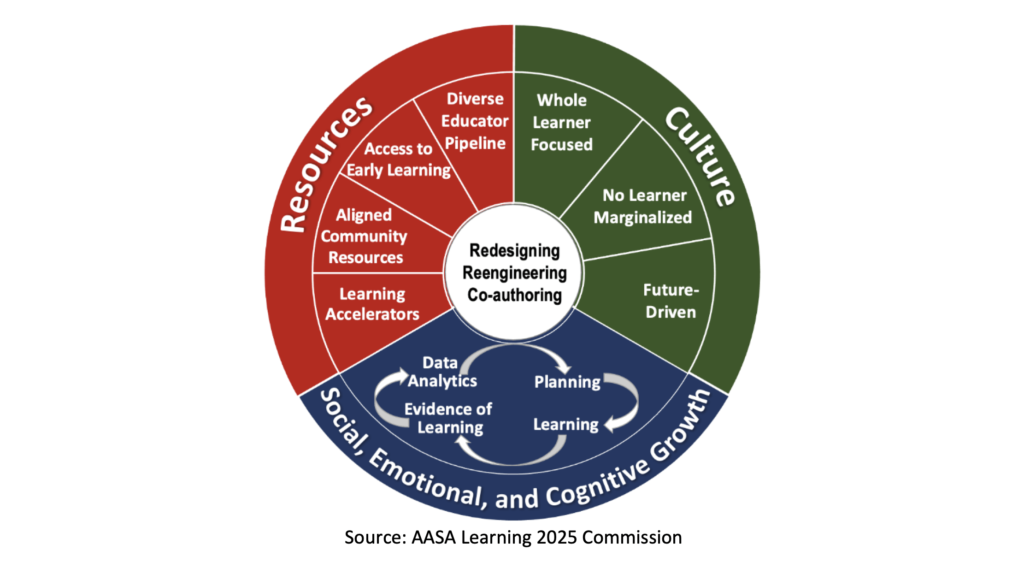School Superintendents Advocate for Whole Child Development

Yesterday a new report was launched by AASA, The School Superintendents Association.
The report, An American Imperative: A New Vision of Public Schools was created by Learning 2025: A National Commission on Student-Centered Equity-Focused Education, a group of superintendents and thought leaders launched earlier this year by AASA.
The report recommends a more whole child approach to learning and development, focusing on many of the key recommendations that organizations like Turnaround for Children and experts like Pamela Cantor MD have been creating over the last few years to better create a process and blueprint for whole child design.
“We could ask the question whether we have the knowledge today to dramatically change the outcomes for young people in ways that promote authentic equity. We do,” said Pamela Cantor MD. “We have the knowledge from the science of learning and development and whole child design to do exactly that. We know enough to act and this is exactly what this commission of diverse, thoughtful and committed educators and community stakeholders, practitioners and scientists came together to do. Everyone understood that the core of what we know will only result in something very different for our young people if we commit to use this knowledge to act in ways that lead to innovations and partnerships that can be scaled.”
Through useful findings, commitments to equity and a rich set of appendices, this new report is a valuable addition to the new surging wellspring of holistic education.
“The report offers a bold vision for whole child education,” said Commissioner Tom Vander Ark. “The concept of learners playing an active role in co-authoring their learning journey is timely and exciting.”
The report also makes a strong stand for equity and calls for all learners, families, and staff to be embraced, valued equally, and served equitably.
The report makes the case that learners, leaders, and teachers are all a part of the education redesign process. For effective design, these stakeholders must be cognizant of the following key components, according to AASA.
1. Culture: Systemic redesign must happen within an intentional, relationships-based culture that is:
- Whole Learner Focused: The entire system must attend to the social, emotional, cognitive, mental health, and trauma-based needs of ALL learners.
- No Learner Marginalized: ALL children, families, and staff must be embraced, valued equally, and served with equity—regardless of race, ethnicity, religion, sexual orientation, gender, socioeconomic circumstance, or disability.
- Future-Driven: Schools must routinely anticipate forthcoming changes in the career, social, economic, and technological landscapes to inform all decisions today.
2. Social, Emotional, and Cognitive Growth Model: Learning must entirely reorient around the learner.
- In order to meet ALL learners’ social, emotional, and cognitive needs, instruction and learning must happen on a growth model continuum, where data analytics, planning, learning, and evidence of learning operate in a feedback loop to personalize learning.
3. Resources: Panels of school, association, state, and federal leaders must convene to determine how to unlock resources to meet ALL children’s Whole Learner needs in the following categories:
- Learning Accelerators: Broadband must be deemed a public utility so that ALL learners have access to the technologies necessary to access and accelerate learning.
- Aligned Community Resources: To meet Whole Learner needs, educators, learners, and learners’ families must have access to a robust, multi-tiered system of supports.
- High-Quality Early Learning for ALL Children: ALL children must engage in high-impact early learning to prepare them to function as co-authors of learning in their K-12 journey.
- Diverse Educator Pipeline: Educators and staff must represent the learners, families, and communities they serve so that true culturally responsive learning is possible.
The report concludes with a series of appendices further explaining critical themes to amplify the commission’s vision for systemic redesign. Attached to each appendix is a specific set of action steps school system leaders are encouraged to implement to successfully redesign their schools. Appendices include:
- Whole Learner Framework and Design
- No Learner Marginalized
- Future Driven
- Learners as Co-Authors of Their Learning Journey
- Growth Model
- Learning Accelerator
- High Quality Early Learning for All Learners
- Diverse Educator Pipeline
- Portraits Of Learners
Stay in-the-know with innovations in learning by signing up for the weekly Smart Update.







0 Comments
Leave a Comment
Your email address will not be published. All fields are required.